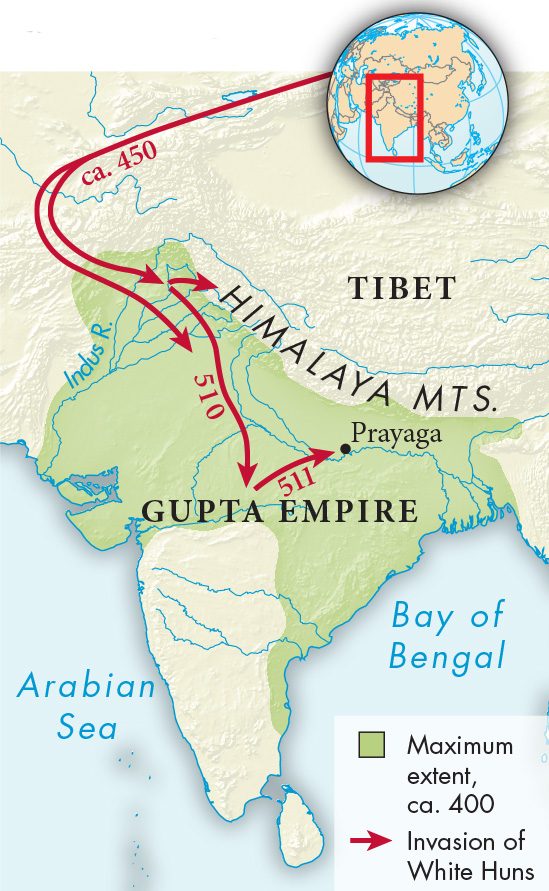The Gupta Empire, ca. 320–480

The Gupta Empire, ca. 320–480
In the early fourth century a state emerged in the Ganges plain that was able to bring large parts of north India under its control. The rulers of this Indian empire, the Guptas, consciously modeled their rule after that of the Mauryan Empire, and the founder took the name of the founder of that dynasty, Chandragupta. Although the Guptas never controlled as much territory as the Mauryans had, they united north India and received tribute from states in Nepal and the Indus Valley, thus giving large parts of India a period of peace and political unity.
The Guptas’ administrative system was not as centralized as that of the Mauryans. In the central regions they drew their revenue from a tax on agriculture of one-quarter of the harvest and maintained monopolies on key products such as metals and salt (reminiscent of Chinese practice). They also exacted labor service for the construction and upkeep of roads, wells, and irrigation systems. More distant areas were assigned to governors who were allowed considerable leeway, and governorships often became hereditary. Areas still farther away were encouraged to become vassal states, able to participate in the splendor of the capital and royal court in subordinate roles and to engage in profitable trade, but did not have to provide much revenue.
The Gupta kings were patrons of the arts. Poets composed epics for the courts of the Gupta kings, and other writers experimented with prose romances and popular tales. India’s greatest poet, Kalidasa (ca. 380–450), like Shakespeare, wrote poems as well as plays in verse. His most highly esteemed play, Shakuntala, concerns a daughter of a hermit who enthralls a king who is out hunting. The king sets up house with her, then returns to his court and, owing to a curse, forgets her. Only much later does he acknowledge their child as his true heir. Equally loved is Kalidasa’s one-hundred-verse poem “The Cloud Messenger” about a demigod who asks a passing cloud to carry a message to his wife, from whom he has long been separated. At one point he instructs the cloud to tell her: “I see your body in the sinuous creeper, your gaze in the startled eyes of deer, your cheek in the moon, your hair in the plumage of peacocks, and in the tiny ripples of the river I see your sidelong glances, but alas, my dearest, nowhere do I see your whole likeness.”5
In mathematics, too, the Gupta period could boast of impressive intellectual achievements. The so-called Arabic numerals are actually of Indian origin. Indian mathematicians developed the place-value notation system, with separate columns for ones, tens, and hundreds, as well as a zero sign to indicate the absence of units in a given column. This system greatly facilitated calculation and had spread as far as Europe by the seventh century.
The Gupta rulers were Hindus, but they tolerated all faiths. Buddhist pilgrims from other areas of Asia reported that Buddhist monasteries with hundreds or even thousands of monks and nuns flourished in the cities. The success of Buddhism did not hinder Hinduism with its many gods, which remained popular among ordinary people.
The great crisis of the Gupta Empire was the invasion of the Huns in about 450. Mustering his full might, the Gupta ruler Skandagupta (r. ca. 455–467) threw back the invaders, but they had dealt the dynasty a fatal blow.
